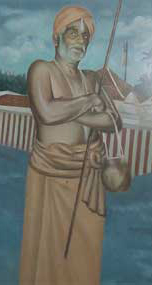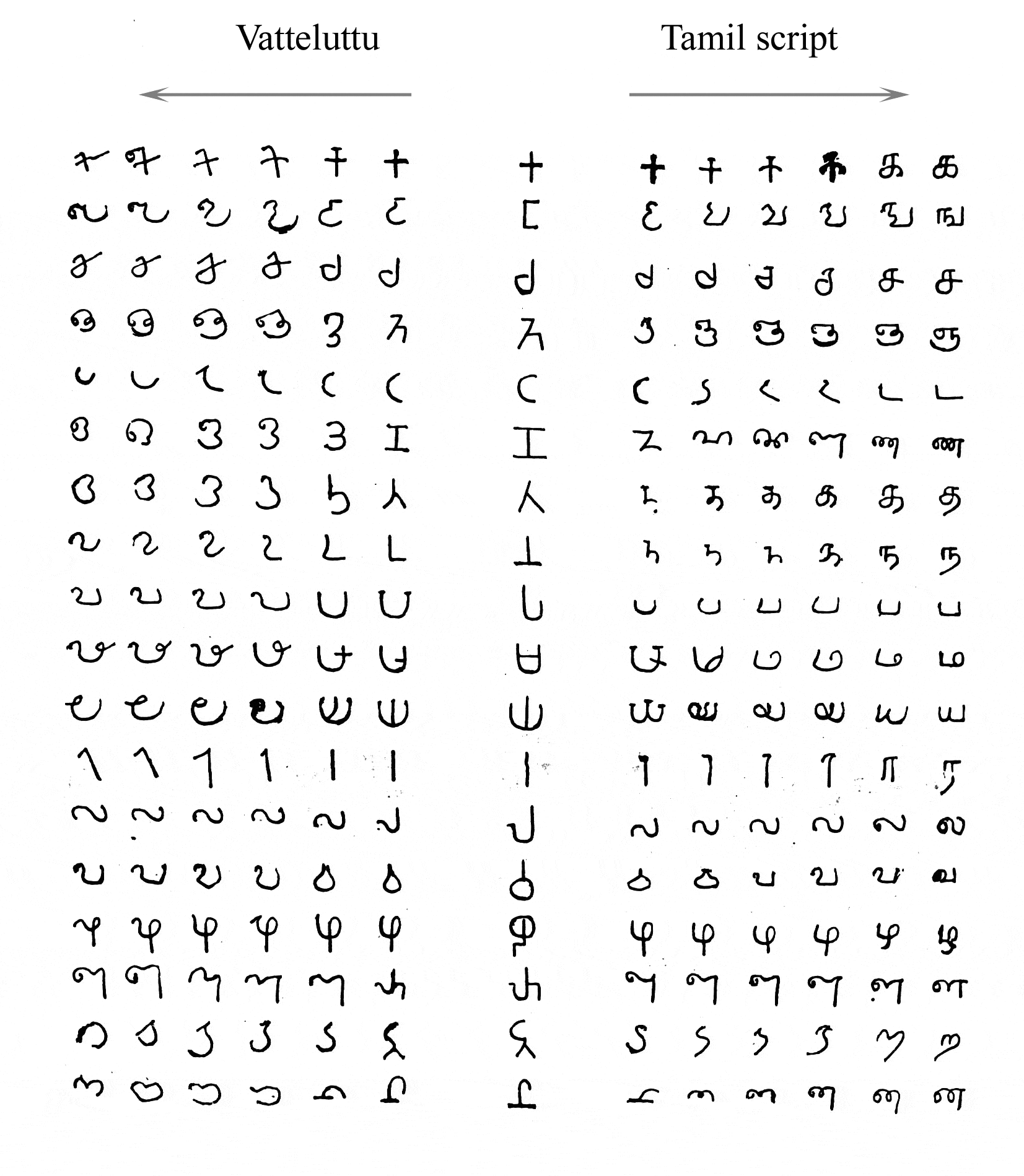|
Citars
According to Akilattirattu Ammanai, the scripture of the Ayyavazhi religion, Ayya Vaikundar, the Incarnation of Lord Narayana in Kali Yukam, has five Seedar (disciples). They were in the previous Dwapara Yukam as Pandavas who were transmigrated as disciples of Vaikundar in this Yuga. The Five Seedar Dharma Seedar The native place of Dharma Seedar is Mayiladi, a town in Kanyakumari district of Tamil Nadu. He was Dharmar, the elder of the Pandavas in the previous Dwapara Yukam. In history he was known as Sivanandi. Bhiman Seedar The native place of Bhiman Citar is Karumbattoor, a village in the district of Kanyakumari. He was Bhima, the most courageous of the Pandavas in the previous Dwapara Yukam. In history he was known as Pantaram (his name). Arjunan Seedar The native place of Arjunan Seedar is Pillayar Kudiyiruppu, a village in the district of Kanyakumari. He was Arjuna, one among Pandavas in the previous Dwapara Yukam. In history he was known as Arjunan. Na ... [...More Info...] [...Related Items...] OR: [Wikipedia] [Google] [Baidu] |
Akilattirattu Ammanai
Akilathirattu Ammanai ( ta, அகிலத்திரட்டு அம்மானை; ''akilam'' ("world"), ''thirattu'' ("collection"), ''ammanai'' ("ballad")), also called Thiru Edu ("venerable book"), is the main religious text of the Tamil belief system Ayyavazhi. The title is often abbreviated to Akilam or Akilathirattu. Akilam includes more than 15,000 verses and is the largest collection of Ammanai literature in Tamil as well as one of the largest works in Tamil constructed by a single author. History Author Hari Gopalan Citar states in the text that he wrote this book on a Friday, the twenty-seventh day of the Tamil month of Karthikai (13 December) in the year 1839 CE. The author claims that God woke him up during his sleep and commissioned him to record his dictation. ''Akilathirattu'' was recorded on palm leaves until 1939, when it was printed.G. Patrick's, Religion and Subaltern Agency, Chapter 5, Page 119 According to the author, the book is the story ... [...More Info...] [...Related Items...] OR: [Wikipedia] [Google] [Baidu] |
Arjuna
Arjuna (Sanskrit: अर्जुन, ), also known as Partha and Dhananjaya, is a character in several ancient Hindu texts, and specifically one of the major characters of the Indian epic Mahabharata. In the epic, he is the third among Pandavas, the five sons of Pandu. The family formed part of the royal line of the Kuru Kingdom. In the Mahabharata War, Arjuna was a key warrior from the Pandava side and slew many warriors including Karna and Bhisma. Before the beginning of the war, his mentor, Krishna, gave him the supreme knowledge of Bhagavad Gita to overcome his moral dilemmas. Arjuna was born when Indra, the god of rain, blessed Kunti and Pandu with a son. From childhood, Arjuna was a brilliant student and was favoured by his beloved teacher, Drona. Arjuna is depicted as a skilled archer, winning the hands of Draupadi, who married the five brothers because of Kunti's misunderstanding and Mahadeva boons. Arjuna is twice exiled, first for breaking a pact with his brothers; ... [...More Info...] [...Related Items...] OR: [Wikipedia] [Google] [Baidu] |
Payyan Dynasty
Payyan dynasty is the family which manage and administer Swamithope pathi, the temple of Ayyavazhi Ayyavazhi ( ta, அய்யாவழி, ml, അയ്യാവഴി ''Ayyāvaḻi'' , ) is a henotheistic belief that originated in South India.Tha. Krishna Nathan, ''Ayyaa vaikuNdarin vaazvum sinthanaiyum'', p. 62: "" (The day at which Vaik .... Payyan in Arul Nool A quote in Arul Nool refers 'Payyan' in Pathiram. References * ''Akilattirattu Ammanai'' published by T.Palaramachandran Nadar, 1989, 9th impression * N.Elango & Vijaya Shanthi Elango ''Ayya Vaikuntar the light of the world'', 1997, The Gurukulam {{Ayyavazhi large History of Ayyavazhi Swamithope pathi ... [...More Info...] [...Related Items...] OR: [Wikipedia] [Google] [Baidu] |
List Of Ayyavazhi-related Articles
A ''list'' is any set of items in a row. List or lists may also refer to: People * List (surname) Organizations * List College, an undergraduate division of the Jewish Theological Seminary of America * SC Germania List, German rugby union club Other uses * Angle of list, the leaning to either port or starboard of a ship * List (information), an ordered collection of pieces of information ** List (abstract data type), a method to organize data in computer science * List on Sylt, previously called List, the northernmost village in Germany, on the island of Sylt * ''List'', an alternative term for ''roll'' in flight dynamics * To ''list'' a building, etc., in the UK it means to designate it a listed building that may not be altered without permission * Lists (jousting), the barriers used to designate the tournament area where medieval knights jousted * '' The Book of Lists'', an American series of books with unusual lists See also * The List (other) * ... [...More Info...] [...Related Items...] OR: [Wikipedia] [Google] [Baidu] |
Tamil Alphabet
The Tamil script ( , ) is an abugida script that is used by Tamils and Tamil speakers in India, Sri Lanka, Malaysia, Singapore, Indonesia and elsewhere to write the Tamil language. Certain minority languages such as Saurashtra, Badaga, Irula and Paniya are also written in the Tamil script. Characteristics The Tamil script has 12 vowels (, , "soul-letters"), 18 consonants (, , "body-letters") and one special character, the (, ). is called "அக்கு", ''akku'' and is classified in Tamil orthography as being neither a consonant nor a vowel. However, it is listed at the end of the vowel set. The script is syllabic, not alphabetic. The complete script, therefore, consists of the 31 letters in their independent form and an additional 216 combinatory letters, for a total of 247 (12+18+216+1) combinations (, , "soul-body-letters") of a consonant and a vowel, a mute consonant or a vowel alone. The combinatory letters are formed by adding a vowel marker to the consonant. ... [...More Info...] [...Related Items...] OR: [Wikipedia] [Google] [Baidu] |
Alphabet
An alphabet is a standardized set of basic written graphemes (called letters) that represent the phonemes of certain spoken languages. Not all writing systems represent language in this way; in a syllabary, each character represents a syllable, and logographic systems use characters to represent words, morphemes, or other semantic units. The first fully phonemic script, the Proto-Sinaitic script, later known as the Phoenician alphabet, is considered to be the first alphabet and is the ancestor of most modern alphabets, including Arabic, Cyrillic, Greek, Hebrew, Latin, and possibly Brahmic. It was created by Semitic-speaking workers and slaves in the Sinai Peninsula (as the Proto-Sinaitic script), by selecting a small number of hieroglyphs commonly seen in their Egyptian surroundings to describe the sounds, as opposed to the semantic values of the Canaanite languages. However, Peter T. Daniels distinguishes an abugida, a set of graphemes that represent consonantal base ... [...More Info...] [...Related Items...] OR: [Wikipedia] [Google] [Baidu] |
Illiterate
Literacy in its broadest sense describes "particular ways of thinking about and doing reading and writing" with the purpose of understanding or expressing thoughts or ideas in written form in some specific context of use. In other words, humans in literate societies have sets of practices for producing and consuming writing, and they also have beliefs about these practices. Reading, in this view, is always reading something for some purpose; writing is always writing something for someone for some particular ends. Beliefs about reading and writing and its value for society and for the individual always influence the ways literacy is taught, learned, and practiced over the lifespan. Some researchers suggest that the history of interest in the concept of "literacy" can be divided into two periods. Firstly is the period before 1950, when literacy was understood solely as alphabetical literacy (word and letter recognition). Secondly is the period after 1950, when literacy slowly ... [...More Info...] [...Related Items...] OR: [Wikipedia] [Google] [Baidu] |
Akilam
Akilathirattu Ammanai ( ta, அகிலத்திரட்டு அம்மானை; ''akilam'' ("world"), ''thirattu'' ("collection"), ''ammanai'' ("ballad")), also called Thiru Edu ("venerable book"), is the main religious text of the Tamil belief system Ayyavazhi. The title is often abbreviated to Akilam or Akilathirattu. Akilam includes more than 15,000 verses and is the largest collection of Ammanai literature in Tamil as well as one of the largest works in Tamil constructed by a single author. History Author Hari Gopalan Citar states in the text that he wrote this book on a Friday, the twenty-seventh day of the Tamil month of Karthikai (13 December) in the year 1839 CE. The author claims that God woke him up during his sleep and commissioned him to record his dictation. ''Akilathirattu'' was recorded on palm leaves until 1939, when it was printed.G. Patrick's, Religion and Subaltern Agency, Chapter 5, Page 119 According to the author, the book is the story ... [...More Info...] [...Related Items...] OR: [Wikipedia] [Google] [Baidu] |
Akilam One
Akilathirattu Ammanai ( ta, அகிலத்திரட்டு அம்மானை; ''akilam'' ("world"), ''thirattu'' ("collection"), ''ammanai'' ("ballad")), also called Thiru Edu ("venerable book"), is the main religious text of the Tamil belief system Ayyavazhi. The title is often abbreviated to Akilam or Akilathirattu. Akilam includes more than 15,000 verses and is the largest collection of Ammanai literature in Tamil as well as one of the largest works in Tamil constructed by a single author. History Author Hari Gopalan Citar states in the text that he wrote this book on a Friday, the twenty-seventh day of the Tamil month of Karthikai (13 December) in the year 1839 CE. The author claims that God woke him up during his sleep and commissioned him to record his dictation. ''Akilathirattu'' was recorded on palm leaves until 1939, when it was printed.G. Patrick's, Religion and Subaltern Agency, Chapter 5, Page 119 According to the author, the book is the story ... [...More Info...] [...Related Items...] OR: [Wikipedia] [Google] [Baidu] |
Adiyeduttharulal
Adiyeduttharulal was an event of Akilam One in Akilattirattu Ammanai, the religious book of Ayyavazhi, which shows the method by which Akilam was written. See also * List of Ayyavazhi-related articles A ''list'' is any set of items in a row. List or lists may also refer to: People * List (surname) Organizations * List College, an undergraduate division of the Jewish Theological Seminary of America * SC Germania List, German rugby union ... Ayyavazhi {{Ayyavazhi-stub ... [...More Info...] [...Related Items...] OR: [Wikipedia] [Google] [Baidu] |




